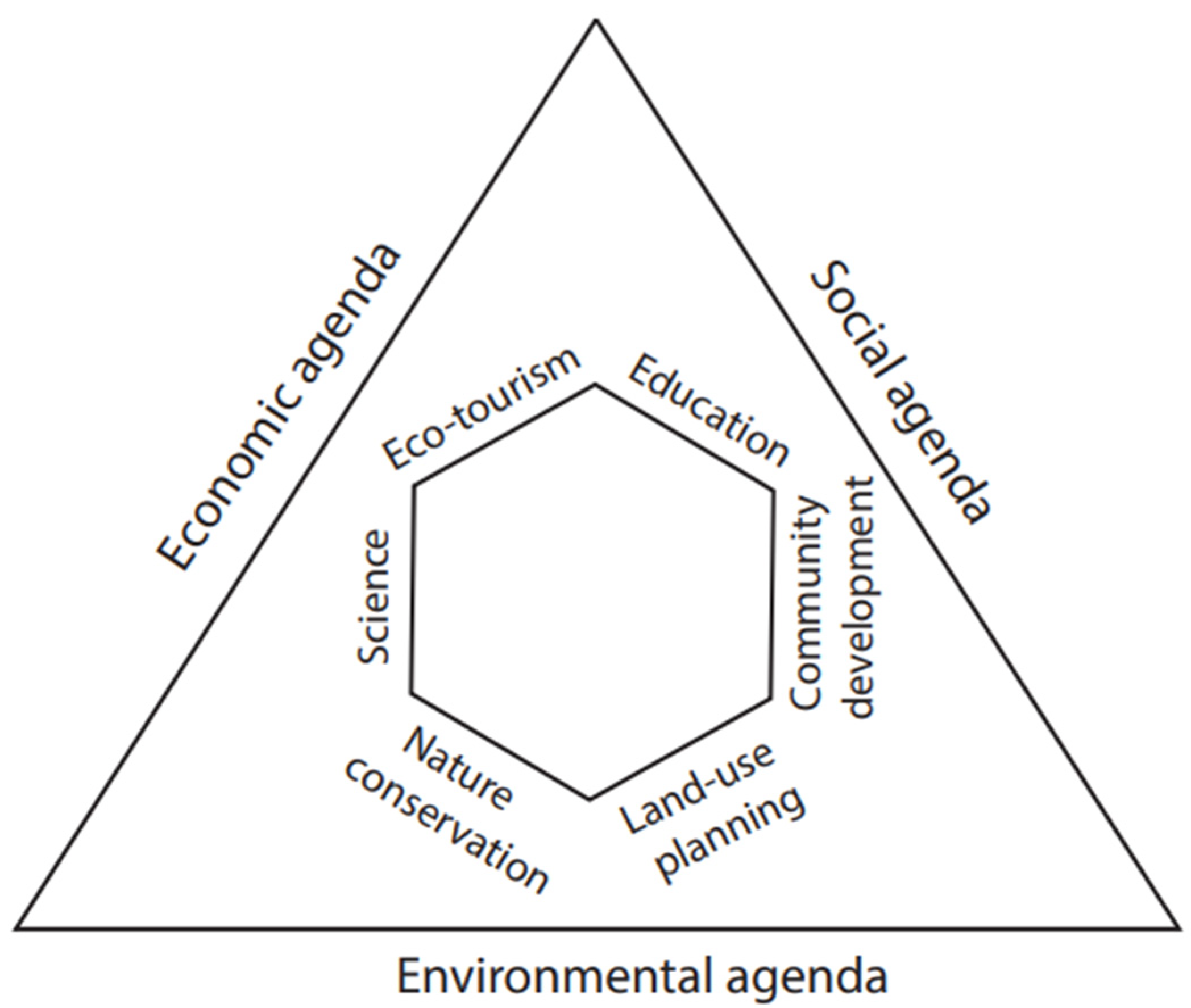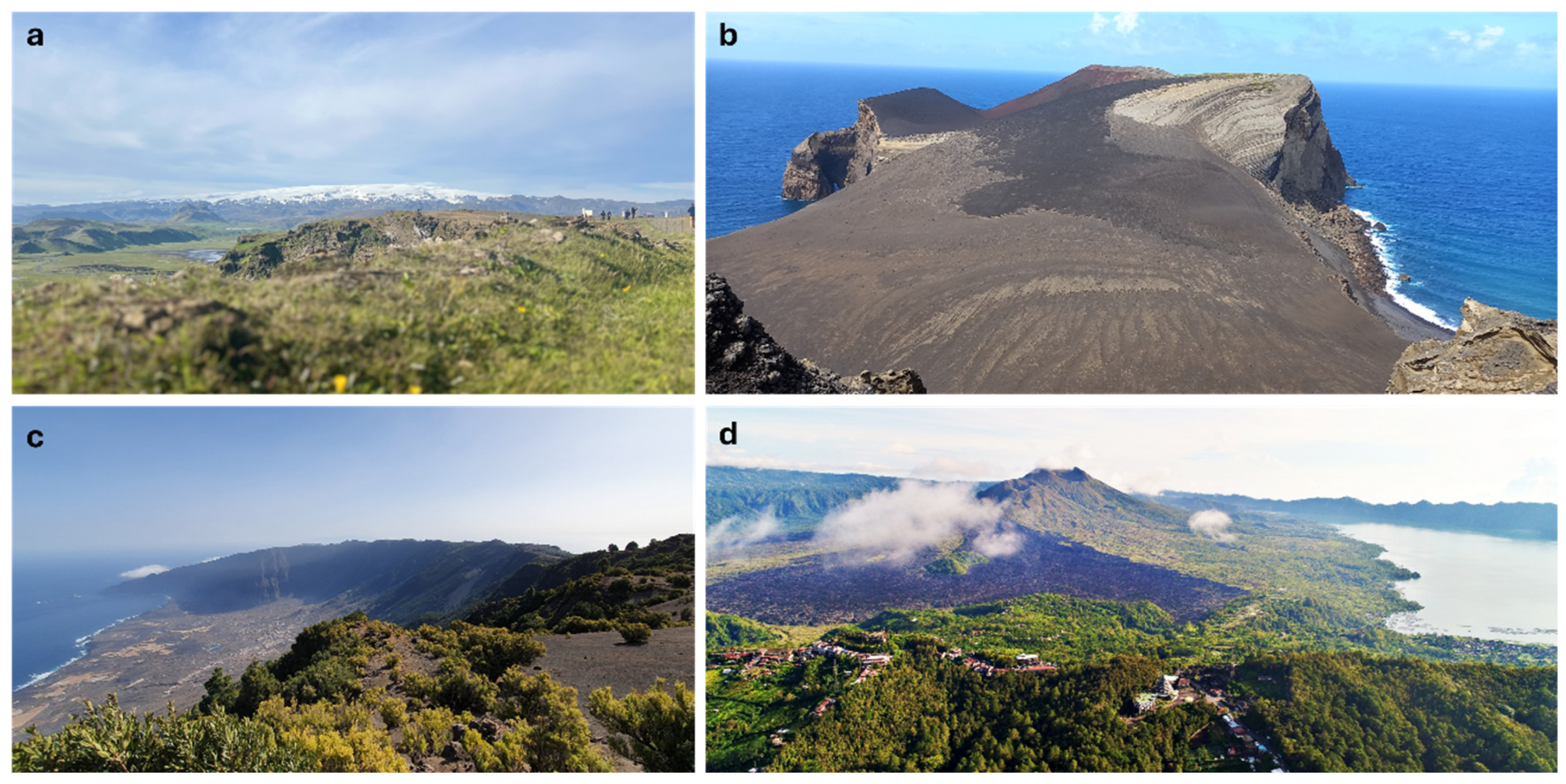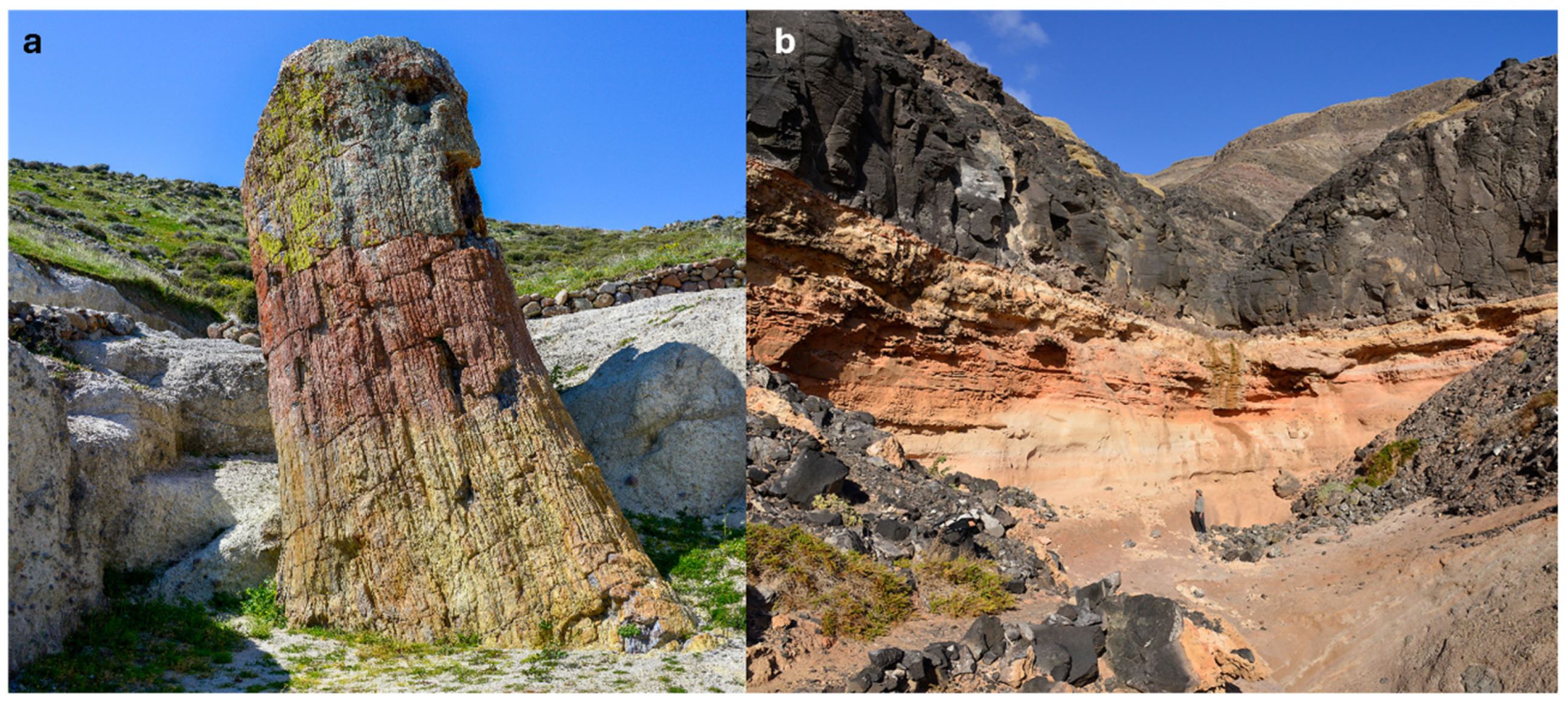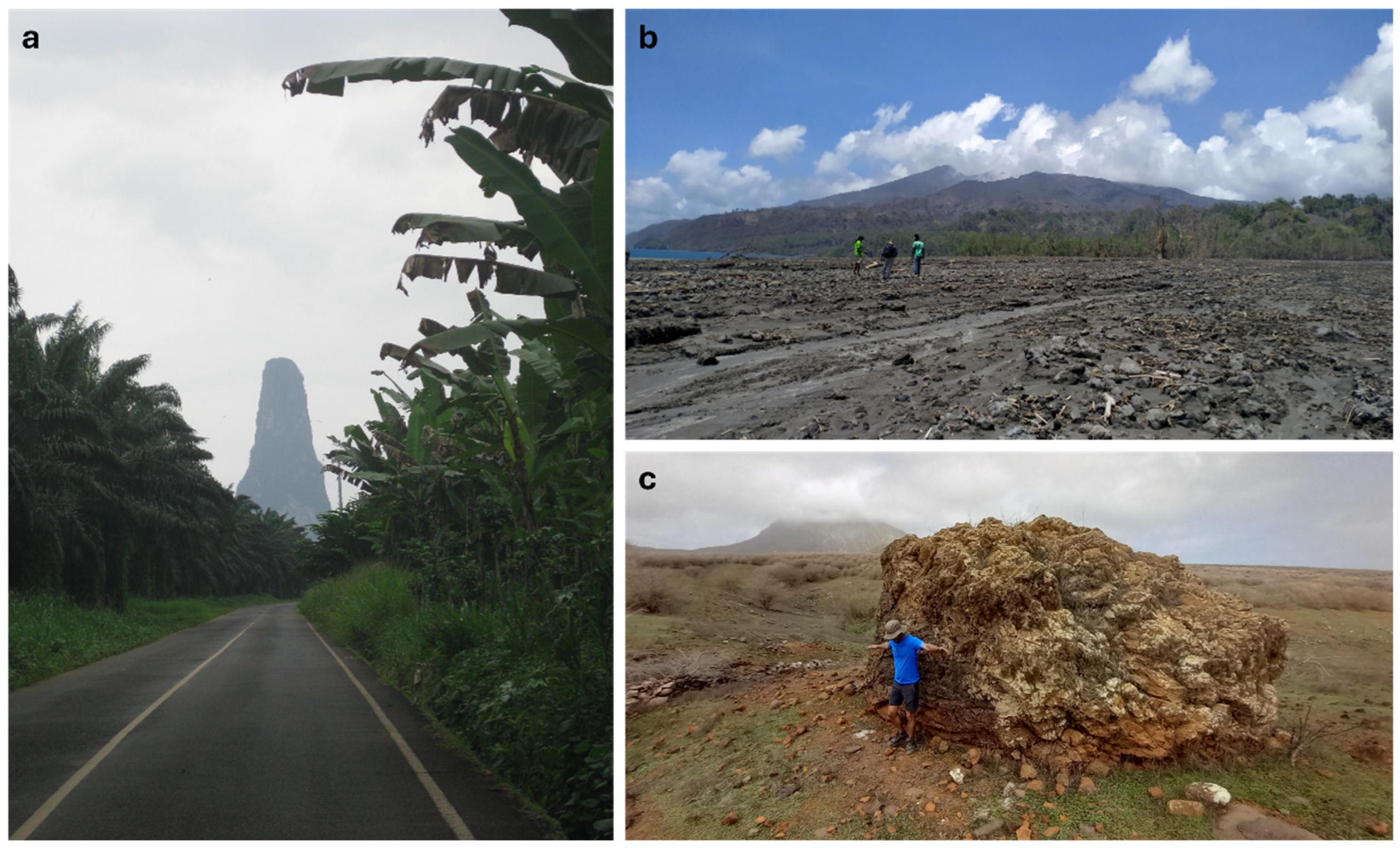Volcanic Islands as Reservoirs of Geoheritage: Current and Potential Initiatives of Geoconservation
Abstract
1. Introduction
2. Materials and Methods
3. Results
3.1. Inventory of UGGp in Volcanic Island Territories
3.2. UGGp Dominated by Quaternary Volcanism and Recent Activity
3.3. Geoparks Representing Broader Geological Narratives
3.4. Alternative Designations That Encompass the Formal Protected Status of Volcanic Island Geosites
3.5. Volcanic Islands with Geoheritage Potential as Future UGGp
4. Discussion
4.1. The Geodiversity Perspective
4.2. The Conservation Perspective
4.3. The Management Perspective
5. Conclusions
Author Contributions
Funding
Acknowledgments
Conflicts of Interest
References
- Pescatore, E.; Bentivenga, M.; Giano, S.I. Geoheritage and geoconservation: Some remarks and considerations. Sustainability 2023, 15, 5823. [Google Scholar] [CrossRef]
- Website for the International Geoscience and Geoparks Programme. 2025. Available online: www.unesco.org/en/iggp/geoparks/about (accessed on 21 May 2025).
- Németh, K.; Casadevall, T.; Moufti, M.R.; Martí, J. Volcanic geoheritage. Geoheritage 2017, 9, 251–254. [Google Scholar] [CrossRef]
- Casadevall, T.; Tormey, D.; Roberts, J. World Heritage Volcanoes: Classification, Gap Analysis, and Recommendations for Future Listings; IUCN: Gland, Switzerland, 2019. [Google Scholar]
- Pimentel, A.; Ramalho, R.S.; Becerril, L.; Larrea, P.; Brown, R.J. Editorial: Ocean island volcanoes: Genesis, Evolution and Impact. Front. Earth Sci. 2020, 8, 82. [Google Scholar] [CrossRef]
- Menard, H.; Ladd, H. Oceanic islands, seamounts, guyots and atolls. In The Sea, 3rd ed.; Hill, M.N., Ed.; Wiley Interscience: New York, NY, USA, 1963; pp. 365–385. [Google Scholar]
- Ramalho, R.S.; Quartau, R.; Trenhaile, A.S.; Mitchell, N.C.; Woodroffe, C.D.; Ávila, S.P. Coastal evolution on volcanic oceanic islands: A complex interplay between volcanism, erosion, sedimentation, sea-level change and biogenic production. Earth Sci. Rev. 2013, 127, 140–170. [Google Scholar] [CrossRef]
- Perfit, M.R.; Davidson, J.P.; Sigurdsson, H. Plate tectonics and volcanism. In Encyclopedia of Volcanoes; Academic Press: Cambridge, MA, USA, 2000; pp. 89–113. [Google Scholar]
- Dóniz-Páez, J.; Beltrán-Yanes, E.; Becerra-Ramírez, R.; Pérez, N.; Hernández, P.; Hernández, W. Diversity of volcanic geoheritage in the Canary Islands, Spain. Geosciences 2020, 10, 390. [Google Scholar] [CrossRef]
- Lima, E.A.; Machado, M.; Guerreiro, M.; Nunes, J.C.; Costa, M.P. Geological heritage management in small islands: The example of the Azores UNESCO Global Geopark (Portugal). Geoheritage 2018, 10, 659–671. [Google Scholar] [CrossRef]
- Pérez-Hernández, E.; Ferrer, N.; Hernández-Calvento, L. Lost and preserved coastal landforms after urban growth. The case of Las Palmas de Gran Canaria city (Canary Islands, Spain). J. Coast. Conserv. 2020, 24, 26. [Google Scholar] [CrossRef]
- Alfama, V.; Henriques, M.H.; Barros, A. The challenging nature of volcanic heritage: The Fogo Island (Cabo Verde, W Africa). Geoheritage 2024, 16, 34. [Google Scholar] [CrossRef]
- Ferrer, N.; Vegas, J.; Galindo, I.; Lozano, G.A. Geoheritage valuation to prevent environmental degradation of a new volcanic landscape in the Canary Islands. Land Degrad. Dev. 2023, 34, 2494–2507. [Google Scholar] [CrossRef]
- Ramos, W.H.; Pérez, N.; Dóniz-Páez, J.; García-Hernández, R. Evaluation of sites of geotouristic interest on active volcanic island La Palma, Spain for potential volcanic tourism. Geoheritage 2024, 16, 102. [Google Scholar] [CrossRef]
- García-Casco, A.; García-Delgado, D. Islands as natural laboratories for geological heritage. Episodes 2023, 46, 289–299. [Google Scholar]
- Zouros, N. Lesvos petrified forest Geopark, Greece: Geoconservation, geotourism, and local development. Geoparks 2010, 27, 19–28. [Google Scholar]
- Henriques, M.H.; Pena dos Reis, R.; Brilha, J.; Mota, T.S. Geoconservation as an emerging geoscience. Geoheritage 2011, 3, 117–128. [Google Scholar] [CrossRef]
- Website for the United Nations Educational Scientific and Cultural Organization Program Related to Its Global Geopark Program in China. Available online: http://www.globalgeopark.org.cn/ (accessed on 15 May 2025).
- Website for the UNESCO Program Related to Geoparks in the Asian Pacific Region. Available online: https://asiapacificgeoparks.org/ (accessed on 15 May 2025).
- Vegas, J.; Galindo, I.; Romero, C.; Sánchez, N.; Díaz, G.A.; Martín-González, E.; Mateo, E. Geoconservation and geotourism in the Lanzarote and Chinijo Islands UNESCO Global Geopark. In Lanzarote and Chinijo Islands Geopark: From Earth to Space, Geoheritage, Geoparks and Geotourism; Mateo, E., Martínez-Frías, J., Vegas, J., Eds.; Springer: Cham, Switzerland, 2019. [Google Scholar] [CrossRef]
- Jousset, P.; Mortensen, A.K.; Fridleifsson, G.O.; Ágústsoon, K.; Gudmundsson, M.T. Reykjanes, Iceland: Structure and dynamics of mid-oceanic ridge geo/hydrothermal systems. J. Volcanol. Geotherm. Res. 2020, 391, 106692. [Google Scholar] [CrossRef]
- Jóhannesson, J.M.; Sigmundsdóttir, B.; Sigursveinsson, S. Volcanic features within Katla UNESCO Global Geopark. Geoconserv. Res. 2023, 6, 53–69. [Google Scholar]
- Lima, E.A.; Meneses, S. Azores UNESCO Global Geopark: Where volcanoes tell us their stories. Geoconserv. Res. 2023, 6, 114–127. [Google Scholar]
- Nunes, J.C. The Azores Archipelago: Islands of geodiversity. In Volcanic Tourist Destinations; Erfurt-Cooper, P., Ed.; Springer: New York, NY, USA, 2014; pp. 57–67. [Google Scholar]
- Casillas, R.; Candelario, Y.P.; Fernández, C.F. El Hierro UNESCO Global Geopark: Geological heritage, geoconservation and geotourism. Geoconservation Res. 2023, 6, 128–138. [Google Scholar]
- Vegas, J.; Galindo, I.; Vázquez, J.T.; León, R.; Sánchez, N.; Martín-González, E.; Romero, C. Tagoro, the Youngest Submarine Volcano in the Spanish Geoheritage Inventory: Scientific Value, Geoconservation and Opportunities for Geotourism. In El Hierro Island; Active Volcanoes of the World; González, P.J., Ed.; Springer: Cham, Switzerland, 2023; pp. 257–272. [Google Scholar] [CrossRef]
- Martín-González, E.; Coello, J.J.; Castillo, C.; González-Rodríguez, A.; Galindo, I.; Vegas, J. Revisión del patrimonio paleontológico del Geoparque Mundial de la Unesco de El Hierro. Geogaceta 2019, 65, 11–17. [Google Scholar]
- Jones, T.E. Evolving approaches to volcanic tourism crisis management: An investigation of long-term recovery models at Toya-Usu Geopark. J. Hosp. Tour. Manag. 2016, 28, 31–40. [Google Scholar] [CrossRef]
- Gomez, C.; Wassmer, P. Evolution of the Unzen Volcano and the Shimabara Peninsula (Japan) during the last 60 years: The role of the 1990–1995 eruption in modifying the landscape. Géomorphologie 2015, 21, 205–216. [Google Scholar] [CrossRef]
- Sato, E.; Fukui, K.; Shimbori, T. Aso volcano eruption on October 8, 2016, observed by weather radars. Earth Planets Space 2018, 70, 105. [Google Scholar] [CrossRef]
- Petraglia, M.D.; Korisettar, R.; Pal, J.N. The Toba volcanic super-eruption of 74,000 years ago: Climate change, environments, and evolving humans. Quat. Int. 2012, 258, 1–4. [Google Scholar] [CrossRef]
- Muzambiq, S.; Sibarani, R.; Nasution, Z.P.; Gustanto, G. Geoheritage and cultural heritage overview of the Toba caldera geosite, North Sumatra, Indonesia. Smart Tour. 2024, 5, 2517. [Google Scholar] [CrossRef]
- Rachmat, H. The Geomorphology of the Rinjani Volcanic Complex, Lombok Island, Indonesia: A Result of a Major Historic Eruption; IAG: París, Francia, 2013. [Google Scholar]
- Reubi, O.; Nicholls, I.A. Structure and dynamics of a silisic magmatic system associated with caldera-forming eruptions at Batur volcanic field, Indonesia. J. Petrol. 2005, 46, 1367–1391. [Google Scholar] [CrossRef]
- Delmelle, P.; Bernard, A. Dowstream composition changes of acidic volcanic waters discharged into the Banyupahit stream, Ijen Caldera, Indonesia. J. Volcanol. Geotherm. Res. 2000, 97, 55–75. [Google Scholar] [CrossRef]
- Jeon, Y.; Ki, J.; Southcott, D. Koren geoheritage: The volcanic landforms of the Jeju Island UNESCO Global Geopark. Episodes 2024, 7, 295–310. [Google Scholar] [CrossRef] [PubMed]
- Wei, F.; Wei, W.; Yu, H. The Cenozoic volcanic fields in northern Hainan Island and Leizhou Peninsula, South China: Eruption history, magma source and dynamic background. Geol. Soc. Lond. Spec. 2020, 510, 179–196. [Google Scholar] [CrossRef]
- Galindo, I.; Vegas, J.; Romero, C.; Llorente, M.; Martín-González, E.; Rubio, J.C.; Díaz, G.A.; Mangas, J.; Mateo, E.; Sánchez, N. Geoheritage inventory of the Lanzarote and Chinijo Islands UNESCO Global Geopark. In Lanzarote and Chinijo Islands Geopark: From Earth to Space, Geoheritage, Geoparks and Geotourism; Mateo, E., Martínez-Frías, J., Vegas, J., Eds.; Springer: Cham, Switzerland, 2019. [Google Scholar] [CrossRef]
- Galindo, I.; Romero, C.; Llorente, M.; Rubio, J.C.; Díaz, G.A.; Sánchez, N.; Martín-González, E.; Mangas, J.; Vegas, J. Geoheritage in the shallow submarine slopes of fan oceanic volcanic edifice: A new option for diving geotourism. In Lanzarote and Chinijo Islands Geopark: From Earth to Space, Geoheritage, Geoparks and Geotourism; Mateo, E., Martínez-Frías, J., Vegas, J., Eds.; Springer: Cham, Switzerland, 2019. [Google Scholar] [CrossRef]
- Martín-González, E.; Galindo, I.; Romero, C.; Sánchez, N.; Vegas, J. Evaluation of geoconservation in geosites of palaeontological interest from Lanzarote and Chinijo Islands UNESCO Global Geopark. In Lanzarote and Chinijo Islands Geopark: From Earth to Space, Geoheritage, Geoparks and Geotourism; Mateo, E., Martínez-Frías, J., Vegas, J., Eds.; Springer: Cham, Switzerland, 2019. [Google Scholar] [CrossRef]
- Wang, J.; Zouros, N. Educational activities in Fangshan UNESCO Global Geopark and Lesvos Island UNESCO Global Geopark. Geoheritage 2021, 13, 51. [Google Scholar] [CrossRef]
- Nakamura, Y.; Yuhora, K. Muroto Geopark: Understanding the moving Earth. In Natural Heritage of Japan: Geoheritage, Geoparks and Geotourism; Chakraborty, A., Mokudai, K., Cooper, M., Watanabe, M., Chakraborty, S., Eds.; Springer: Cham, Switzerland, 2018. [Google Scholar] [CrossRef]
- Nanjo, K.Z.; Yukutake, Y.; Kumazawa, T. Changes in Seismicity in a Volcanically Active Region of the Izu Peninsula, Japan. 2024. Available online: https://ssrn.com/abstract=5097110 (accessed on 30 April 2025).
- Irzon, R.; Samodra, H.; Permanadewi, S. Prospecting CCS project in Indonesia: A case study in Meratus Mountains, South Borneo. J. Geol. Miner. Resour. 2024, 25, 31–40. [Google Scholar] [CrossRef]
- Ávila, S.P.; Cachão, M.; Ramalho, R.S.; Botelho, A.Z.; Madeira, P.; Rebelo, A.C.; Cordeiro, R.; Melo, C.; Hipólito, A.; Ventura, M.A.; et al. The palaeontological heritage of Santa Maria Island (Azores: NE Atlantic): A re-evaluation of geosites in geopark Azores and their use in geotourism. Geoheritage 2016, 8, 155–171. [Google Scholar] [CrossRef]
- Meireles, R.P.; Quartau, R.; Ramalho, R.S.; Rebelo, A.C.; Madeira, J.; Zanon, V.; Ávila, S.P. Depositional processes on oceanic island shelves—Evidence from storm-generated Neogene deposits from the mid-North Atlantic. Sedimentology 2013, 60, 1769–1785. [Google Scholar] [CrossRef]
- Rebelo, A.C.; Rasser, M.W.; Kroh, A.; Johnson, M.E.; Ramalho, R.S.; Melo, C.; Uchman, A.; Berning, B.; Silva, L.; Zanon, V.; et al. Rocking around a volcanic island shelf: Pliocene rhodolith beds from Malbusca, Santa Maria Island (Azores, NE Atlantic). Facies 2016, 62, 22. [Google Scholar] [CrossRef]
- Harbowo, D.G. An assessment of the scientific value of Krakatoa, Indonesia from a geoheritage perspective. J. Appl. Geosci. Eng. 2023, 2, 11–25. [Google Scholar] [CrossRef]
- Sendjaja, P.; Suparka, E.; Botjing, M.U. Geodiversity of the Togean Islands National Park, Central Sulawesi Province for Geopark Assessment. IOP Conf. Ser. Earth Environ. Sci. 2020, 589, 012023. [Google Scholar] [CrossRef]
- Fepuleai, A.; Nemeth, K. Volcanic geoheritage of landslides and rockfalls on a tropical ocean island (Western Samoa, SW Pacific). Geoheritage 2018, 11, 577–596. [Google Scholar] [CrossRef]
- Migon, P.; Pijet-Migon, E. Geoconservation and tourism at geothermal sites—Lessons learnt from the Taupo volcanic zone, New Zealand. Proc. Geol. Assoc. 2016, 127, 413–421. [Google Scholar] [CrossRef]
- Henriques, M.H.; Neto, K. Geoheritage at the Equator: Selected geosites of Sao Tomé Island (Cameron Line, Central Africa). Sustainability 2015, 7, 648–667. [Google Scholar] [CrossRef]
- Henriques, M.H.; Neto, K.A. Geo-itinerary to foster sustainable tourism in West African Islands: Storytelling the evolution of the ancient Cameroon Volcanic Line coral reefs. Sustainability 2023, 15, 16863. [Google Scholar] [CrossRef]
- Moreira, J.C.; Vale, T.F.; Burns, R.C. Fernando de Noronha Archipelago (Brazil): A Coastal Geopark Proposal to Foster the Local Economy, Tourism and Sustainability. Water 2021, 13, 1586. [Google Scholar] [CrossRef]
- Michon, L.; Di Muro, A.; Villeneuve, N.; Saomt-Marc, C.; Fadda, P.; Manta, F. Explosive activity of the summit of Piton de la Fournaise volcano (La Réunion Island): A historical and geological review. J. Volcanol. Geotherm. Res. 2013, 264, 117–133. [Google Scholar] [CrossRef]
- Carrión-Mero, P.; Sánchez-Zambrano, E.; Mata-Perelló, J.; Jaya-Montalvo, M.; Herrera-Franco, G.; Berrezueta Espinel, R.; Baque, M.; Morante-Carballo, F. Geosites assessment in a volcanic hotsot environment and its impart on geoturism, Santa Cruz-Galapagos Islands, Ecuador. Int. J. Geoherit. Parks 2024, 12, 147–167. [Google Scholar] [CrossRef]
- Johnson, M.E.; Ledesma-Vázquez, J. Gulf of California Coastal Ecology: Insights from the Present and Patterns from the Past; Sunbelt Publications: San Diego, CA, USA, 2016; 134p. [Google Scholar]
- da Silveira, A.B.; Prada, S.; Ramalho, R.; Madeira, J.; Fonseca, P.; Canha, E.; Brilha, E. Inventariaço do património geológico da Ilha da Madeira. Secretaria Regional do Ambiente e Recursos Naturais—Relatório Final 2012, 414p. Available online: https://geodiversidade.madeira.gov.pt (accessed on 23 June 2025).
- Sotiriou, P.; Nunes, P. The geoheritage of Madeira: Implications for Natural Heritage and geotourism. Geoheritage 2024, 16, 74. [Google Scholar] [CrossRef]
- Francaviglia, V. Characterization of Mediterranean obsidian sources by classical petrochemical methods. Preist. Alp. 1984, 20, 311–332. [Google Scholar]
- Keller, J. Lipari’s fiery past: Dating the medieval pumice eruption of Monte Pelato. In Proceedings of the International Conference ‘The Fire Between Air and Water’, UNESCO-Regione, Siciliana, Lipari, Italy, 29 September–2 October 2002. [Google Scholar]
- Friedrich, W.L.; Heinemeier, J. The Minoan eruption of Santorini radiocarbon dated to 1613 ± 13 BC—Geological and stratigraphic considerations. In Time’s Up! Dating the Minoan Eruption of Santorini; Warburton, D.A., Ed.; Monographs of the Danish Institute: Athens, Greece, 2009; Volume 10, pp. 57–63. [Google Scholar]
- Preine, J.; Karstens, J.; Hübscher, C.; Druitt, T.; Kutterolf, S.; Nomikou, P.; Manga, M.; Gertisser, R.; Pank, K.; Beethe, S.; et al. Hazardous explosive eruptions of a recharging multi-cyclic island arc caldera. Nat. Geosci. 2024, 17, 323–331. [Google Scholar] [CrossRef]
- Raška, P.; Pokomý, R.; Krmíček, L.; Kubouškova, S.; Mortensen, L. Basaltic dyke with specific volcanogenic structures and its geomorphic evolution: Unique geoheritage of the Faroe Islands (North Atlantic Ocean). Geoheritage 2019, 11, 417–426. [Google Scholar] [CrossRef]
- Jicha, B.R.; Scholl, D.W.; Singer, B.; Yogodzinski, G.; Kay, S.M. Revised age of Aleutian Island Arc formation implies high rate of magma production. Geology 2006, 34, 661–664. [Google Scholar] [CrossRef]
- Wood, C.A. Volcanoes of the World. In Encyclopedia of Volcanoes; Sigurdsson, H., Ed.; Academic Press: Cambridge, MA, USA, 2009; pp. 3–17. [Google Scholar]
- Németh, K. Volcanic Geoheritage in the Light of Volcano Geology. In El Hierro Island Global Geopark; Dóniz-Paez, J., Pérez, N.M., Eds.; Springer: Berlin/Heidelberg, Germany, 2023; pp. 1–32. [Google Scholar] [CrossRef]
- Gray, M. Geodiversity: Valuing and Conserving Abiotic Nature, 2nd ed.; Wiley-Blackwell: Hoboken, NJ, USA, 2013. [Google Scholar]
- Brilha, J. Inventory and quantitative assessment of geosites and geodiversity sites: A review. Geoheritage 2016, 8, 119–134. [Google Scholar] [CrossRef]
- Saffache, P.; Angelelli, P. Environmental challenges in the small islands of the Caribbean: The example of Martinique. Caribb. Geogr. 2010, 15, 83–95. [Google Scholar]
- Chakraborty, A.; Mogi, K.; Takemura, K. Geosystem and geopark: A holistic approach to natural hazard studies in the Izu Peninsula Geopark, Japan. J. Geol. Soc. India 2015, 86, 525–533. [Google Scholar]
- Reynard, E.; Brilha, J. (Eds.) Geoheritage: Assessment, Protection, and Management; Elsevier: Amsterdam, The Netherland, 2018. [Google Scholar] [CrossRef]





| Geopark/Country | Year | Area (km2) | Base Age | Key Geological Features |
|---|---|---|---|---|
| Toya-Usu, Japan | 2008 | 1181 | Quaternary | Pyroclastic flow forming caldera depression |
| Unzen Area, Japan | 2009 | 459 | Pliocene | Lava domes and pyroclastic deposits |
| Aso Area, Japan | 2013 | 2 | Quaternary | Lava flows and tephra layers |
| Oki Islands, Japan | 2013 | 674 | Permian-Triassic | Volcanic rocks and mantle xenoliths; aquatic fossils |
| Mt. Apoi, Japan | 2015 | 364 | Miocene | Peridotites from earth’s mantle |
| Itoigawa, Japan | 2015 | 750 | Cambrian | East-West tectonic line of separation |
| San’lin Kaigan, Japan | 2015 | 246 | Miocene | Granite outcrops and other volcanics |
| Muroto, Japan | 2015 | 248 | Paleogene | Accretionary complex at plate boundary |
| Izu Peninsula, Japan | 2016 | 2027 | Miocene | Pillow lava; pumice; scoria cone, hot spring |
| Hakusan Tedorigawa, Japan | 2023 | 755 | Permian | Continental collision; dinosaur tracks |
| Batur, Indonesia | 2012 | 370 | Quaternary | Lava flows, fumaroles, lake calderas |
| Ciletuh-Palabuhanratu, Indonesia | 2015 | 1260 | Oligocene | Tectonic processes, hot springs; geysers |
| Rinjani-Lombock, Indonesia | 2018 | 2800 | Oligocene | Intrusive igneous rocks and volcanoes |
| Toba Caldera, Indonesia | 2020 | 1165 | Quaternary | Landscape from a plinnian eruption |
| Ijen Lake, Indonesia | 2023 | 4723 | Quaternary | The world’s most acidic volcanic lake with sulfuric gases that ignite blue flames |
| Kebjumen, Indonesia | 2025 | 1139 | Early Cretaceous | Tectonic records dating back 119 million years; caves, and underground rivers |
| Meratus, Indonesia | 2025 | 3645 | Early Jurassic | Indonesia’s oldest and most complete ophiolite sequence |
| Leiquiong, Hainan, China | 2015 | 3050 | Quaternary | Basaltic and phreatomagmatic craters |
| Katla, Iceland | 2015 | 9542 | Quaternary | Fissures and hyaloclastite ridges; ice-capped volcanoes and tuff deposits |
| Jeju Island, Republic of Korea | 2010 | 1847 | Quaternary | Basaltic—trachytic lavas; tuff rings and cones |
| Reykjanes, Iceland | 2014 | 825 | Quaternary | Fissure swarms and geothermal fields |
| Lesvos Island, Greece | 2015 | 1636 | Miocene | Volcanic hot springs and fossil sites |
| El Hierro Island, Spain | 2014 | 595 | Quaternary | Gravitational landslides; pyroclastic cones |
| Lanzarote and Chinijo Islands, Spain | 2015 | 250 | Miocene | Prehistoric and historic volcanism; fossils; aeolian deposits, submarine processes |
| Azores islands, Portugal | 2013 | Miocene | Caldera lakes, fumaroles, and hot springs; steam-cooked meals |
| Island | Base Age | Key Geological Features |
|---|---|---|
| Krakatoa (Indonesia) | Quaternary | Catastrophic historical volcanism |
| Togean Islands (Indonesia) | Neogene-Quaternary | Volcanoes, lava domes, karst, and ophiolites |
| Samoa (Samoa) | Quaternary | Active geodynamic processes (tsunamis, earthquakes, volcanoes) |
| Gwanmae Island (Republic of Korea) | Quaternary | Volcanic landscape |
| North Island (New Zealand) | Quaternary | Stratovolcanoes of Tongariro Area, Taupo geothermal fields |
| Fogo, Santo Antão and Santiago (Cabo Verde) | Neogene-Quaternary | Active volcanism, tsunami deposits |
| São Tomé and Príncipe (São Tomé and Príncipe) | Neogene-Quaternary | Alkaline volcanism |
| Annobón (Equatorial Guinea) | Neogene | Submerged geomorphology, coral platforms |
| Madeira (Portugal) | Neogene | Volcanism, coastal geomorphology, fossils deposit |
| Etna (Sicily) and Aeolian Islands (Italy) | Quaternary | Active and historic volcanoes, cultural heritage |
| Santorini Island (Greece) | Pliocene-Quaternary | Active caldera subsidence |
| Faroe Islands (Denmark) | Eocene | Ancient volcanic landscapes, unique geoforms |
| Aleutian Islands Arc (United State) | Neogene-Quaternary | More than fifty active volcanoes |
| Fernando Noronha (Brazil) | Neogene-Quaternary | Noronha hotspot |
| Réunion Island (France) | Quaternary | Pitons, cirques and ramparts |
| Saint Vicent (Saint Vincent and the Grenadines) | Pliocene | La Soufrière volcano, lahars |
| Galápagos (Ecuador) | Quaternary | Insular volcanism, calderas, active geosites |
| Coronados Island, Baja California (Mexico) | Quaternary | Volcanic cone and lagoon with fossil corals |
| Carmen Island, Baja California (Mexico) | Neogene | Tide-water delta in a volcanic landscape |
| Danzante Island, Baja California (Mexico) | Neogene | Andesite flows and coastal rock pediments |
| Monserrat Island, Baja California (Mexico) | Neogene | Tilted andesite covered by Pliocene limestone |
Disclaimer/Publisher’s Note: The statements, opinions and data contained in all publications are solely those of the individual author(s) and contributor(s) and not of MDPI and/or the editor(s). MDPI and/or the editor(s) disclaim responsibility for any injury to people or property resulting from any ideas, methods, instructions or products referred to in the content. |
© 2025 by the authors. Licensee MDPI, Basel, Switzerland. This article is an open access article distributed under the terms and conditions of the Creative Commons Attribution (CC BY) license (https://creativecommons.org/licenses/by/4.0/).
Share and Cite
Martín-González, E.; Vegas, J.; Galindo, I.; Romero, C.; Sánchez, N. Volcanic Islands as Reservoirs of Geoheritage: Current and Potential Initiatives of Geoconservation. J. Mar. Sci. Eng. 2025, 13, 1420. https://doi.org/10.3390/jmse13081420
Martín-González E, Vegas J, Galindo I, Romero C, Sánchez N. Volcanic Islands as Reservoirs of Geoheritage: Current and Potential Initiatives of Geoconservation. Journal of Marine Science and Engineering. 2025; 13(8):1420. https://doi.org/10.3390/jmse13081420
Chicago/Turabian StyleMartín-González, Esther, Juana Vegas, Inés Galindo, Carmen Romero, and Nieves Sánchez. 2025. "Volcanic Islands as Reservoirs of Geoheritage: Current and Potential Initiatives of Geoconservation" Journal of Marine Science and Engineering 13, no. 8: 1420. https://doi.org/10.3390/jmse13081420
APA StyleMartín-González, E., Vegas, J., Galindo, I., Romero, C., & Sánchez, N. (2025). Volcanic Islands as Reservoirs of Geoheritage: Current and Potential Initiatives of Geoconservation. Journal of Marine Science and Engineering, 13(8), 1420. https://doi.org/10.3390/jmse13081420







